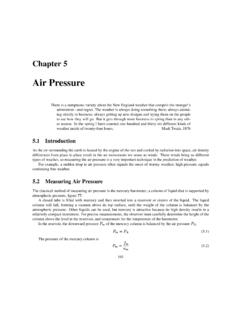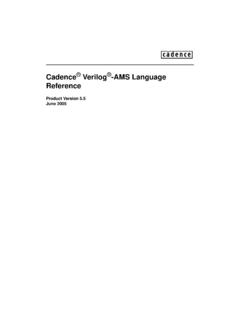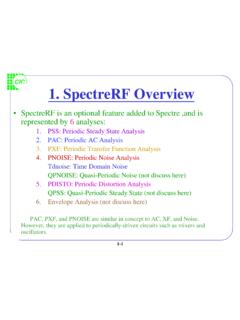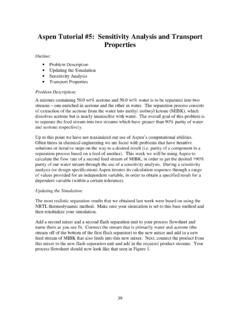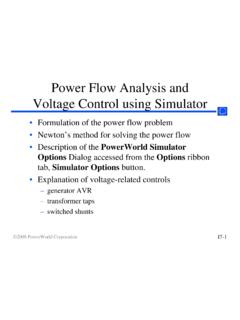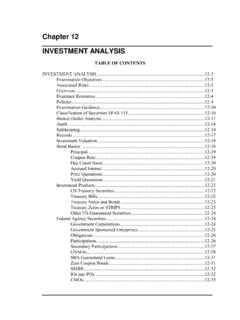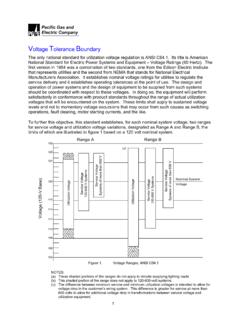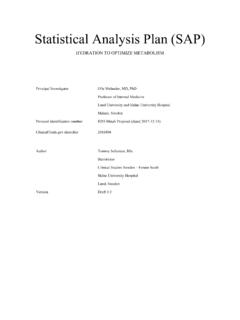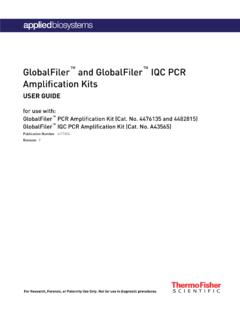Transcription of CIC 1.SpectreRF Overview
1 Overview SpectreRF is an optional feature added to Spectre ,and isrepresented by6 : Periodic Steady State : Periodic AC : Periodic Transfer Function : Periodic Noise AnalysisTdnoise: Time Domain NoiseQPNOISE: Quasi-Periodic Noise (not discuss here) : Periodic Distortion AnalysisQPSS: Quasi-Periodic Steady State (not discuss here) analysis (not discuss here)PAC, PXF, and PNOISE are similar in concept to AC, XF, and , they are applied to periodically-driven circuits such as mixers in a Design FlowSchematicModelsThe netlists include allcomponents along with ananalysis selection, simulationcontrols and statements to save,plot nodes or Direct plot or theCalculator plot ControlDesignNetlistAnalog Artist EnvironmentAnalog Artist Plot ResultsSPECTRE EngineCIC1-3 SpectreRF Tool FlowPSS is a large-signal analysisand determines the period ofthe small-signal requires that multipleperiodic stimuli is also a large-signal analysis , and need notto be run after a PSSanalysis.
2 PDISTO does notrequire multiple periodicstimuli to be EnginePSS AnalysisPSS setupPSS ResultsPDISTO ResultsPDISTO SetupSpectre EnginePDISTO AnalysisSpectreEngine-PAC analysis -PXF analysis -PNOISE AnalysisReport ResultsStimuli iscoperiodicYesNoCIC1-4 SpectreRF Features Compute a steady-state solution efficiently and directly Handles very large circuits (~ 10,000 transistors) Displays results in both time and frequency domains Use Discrete Fourier Transform (DFT) for better accuracy Displays standard RF measurements, such ass-parameter in Smithchart,NF,IP3, and1dB compression pointin the Analog Artist designenvironment. Performs oscillator analysis Linear Simulation: Entirely in the frequency domain A basic RF feature of the Spectre simulator Ports: Specify the port number on thepsin( orport);psin(orport)can act as a source port or a load. Required properties for linear analysis :Resistance&Portnumber Noise analysis : UseNfminand NF for 2-port circuits S-Parameter Simulation ResultsSP, ZP, YP, HP s-, z-, y-, and h-parametersGD group delayVSWR Voltage Standing Wave RatioNFmin minimum noise figureGmin reflection coefficient associated withNfmin(also known as min, opt, or on)Rn noise sensitivity parameterrn normalized equiv.
3 Noise resistanceNF noise figureKf& B1f stability termsGT transducer gainGA available gain, assuming conjugate matched outputGP power gain, assuming conjugate matchedinputGmax maximum available power gainGmsg maximum stable power gainGumx maximum unilateral power gainZM impedance at port mNC noise circlesGAC available gain circlesGPC power gain circlesLSB load stability circlesSSB source stability circlesCIC2-3 Lab1 : S-parameter analysis Create a new libraryand a new schematicview. Use library analogLib & tsmc25rf to drawthe scheme. After drawing, pushDesign CheckandSave; then pushTools AnalogEnvironment, and thewindow AffirmaAnalog Circuit DesignEnvironment instance fromlibrary tsmc25rf CIC2-4 Setup Design Environment(1) PushSetup ModelLibrariesthen the window Model Library Setup appears.
4 Setup the modellibrary as shown right. Thenclick OK. PushSetup Simulator/Directory/Hostto designate the projectdirectory. The default projectdirectory is ~/simulation .Use Browse to access to the model filesCIC2-5 Setup Design Environment(2) You can use either anabsolute model pathor arelative model path IF you use the absoluteapproach, the setup is asshown right-upper. To use a relative path ,push Setup SimulationFiles ,thanSetup Model is as shown Design Environment(3) PushAnalyses Choosethen the window Choosing Analyses appears. Key in thevalues as right and push ok, then someinformation will appear in the Analyses domain of the window Affirma AnalogCircuit Design Environment . PushSimulation Netlist and Runto runthe simulation. The Netlist will be saved undera directory called~ and RunPushSelectbutton thento select the port on theschematic windowCIC2-7 See the Results Use the Direct Plot tool to look the results. In the S-parameter Results window choose someparameters to see their ResultsCIC2-9 Save the results to *.
5 S2p Edit the S-Parameter Options,and enter the path to the outputS-parameter file in the filefield of the OUTPUTPARAMETERS section andOK the S-Parameter Optionsform. And Simulate again. Check ifthe file is created in theappointed FileCIC2-11 Simulation State PushSession Save Stateto save simulation states under a directorycalled~/.artist_states. Designate a new directory with theSession Optionscommand in the simulation window. PushSession Save Statetoload saved states for a the S2P file(1) Create a new schematicview. Use library analogLib (n2portcell) to draw thescheme. Simulate if the resultsare the same as : Swept DC analysis Create a new schematic view and use library analogLib & tsmc25rf to draw the scheme.. After Checkand Save ; then call the window Affirma Analog Circuit Design Environment . Setupup theModel Libraries. PushVariables Copy From Cellview, and thedefined variables appear in the DesignVariables section. Double click onthe variable name or pushVariables Edit, the window Editing Design Variables appears.
6 Key in the appropriate value for the up the Design Environment(1) Call the window Choosing Analyses and key in the values as right and push ok. To plot power or current at the end of the simulation,you must explicitly save the currents necessary forthe calculation before the simulation. The voltages ateach node are saved by default. SelectOutputs To BeSaved Select OnSchematic. In theschematic, select theNMOS. The terminals arecircled in the schematicwindow after you selectthem. PressEscto end up the Design Environment(2) In the window Design Environment selectTools Parametric ;the window Parametric analysis appears, then key in the values as below . In the window ParametricAnalysis selectAnalysis Startto start Results SelectResults Direct Plot DCand select the terminal Drain of thenmosinthe schematic window; then pushESC, and the results will be Steady State analysis Directly computes the periodic steady-state response of a circuit inthe time domain.
7 Iterative Shooting Newton method is employed. Calculate frequency translations using the saved matrices at everytime point. The fundamental frequency of the circuit or system is determined,based on integer multiples of all source frequencies. The circuit is evaluated for one period of the common frequency,and the period is adjusted until all node voltages and all branchcurrents fall within a specified Newton Method PSS operates by efficientlyfinding an initial condition thatresults in steady state. The first iteration istransientsimulation fromt=0tot=1/PSSfundby default. Thetstabparametercan be adjusted to facilitateconvergence. The second iteration isPSSanalysis betweent=tstabtot=(tsatb+1/PSSfund)and comparesall voltage and currents at the startand end of the shooting the value oftstabto keep start-up behavior starting point is adjustedby the shooting method toresult in periodic steady signal starts at apoint vidoesn'tresult in vtstabt=0st=1/PSSfundt=2/PSSfundTransien t AnalysisPSS AnalysisAll node voltagesand AdmittanceMatrices are savedShootingIntervalCIC4-3 Shooting Newton Method(continued)fundPSS1 =fundPSS1 =Transient AnalysisPSS AnalysisRF 100 MHzPSSfund=100 MHz Shooting method takes the last few point data at theend of the shooting interval to adjust the slopes of thewaveform at the beginning of the next iteration.
8 If 20 iterations do not yield a solution, this mightindicate the circuit won t converge to a PSS analysis Assumptions 1st Assumption :Periodicity All stimuli are periodic and coperiodic with the PSSfund; Allresponses are periodic. PSSfund can be set to includes the subharmonics. If periodicity assumptions fail, PSS analysis will not converge. 2ndAssumption :Linearity A near-linear relationship need to exist between initial and finalpoints of the shooting PSS Fundamental150 MHzRF 10 MHzCIC4-6 PSS OperationYesYesNoNoStart PSSI nitial Transient(1 period ortstab)1 Period ofPSS AnalysisPeriodicity Meet?Final State=Initial StateExitRefineInitialGuessCIC4-7 Simulator Accuracy Suggestions Do not set conservative . This will dramatically extend the simulation time. The suggested settings are recommended for IP3 analysis , Noise analysis ,or wherever high accuracy is needed. Choose the gear2only integration method. The default trap integrationgear2onlytrapMethod1e-131e-12 iabstol3e-81e-6vabstol1e-51e-3reltolSugg ested < < < *lteratio*reltol Iand V<method yieldsunderdamping andgearOne yields toomuch Convergence ratio When the Conv norm is 1(unity) or less, the simulationmeets the matching criterion.
9 The PSS messages also display the number of PSSiterations, the number of accepted timesteps, and the totaltime required for PSS norm=Measured V between start and end of shooting intervalreltol*lteratio*steadyratioCIC4- 9 Lab3 : PSS and swept PSS AnalysisCreate a newschematic view anduse library analogLib & tsmc25rf to drawthe :Frequency name: F1 Resistance: 50 Source type: sineAmplitude(dBm):-40 Frequency:frfPort2:Frequency name: F2 Resistance: 50 Source type: sineAmplitude(dBm): 8 Frequency:floPifCIC4-10 Setup up the PSS Simulation(1) Model library setup. Call the window AffirmaAnalog Circuit Design Environment ; key inappropriate value for the variablesin the Design Variables section. Analyses Choose. In thewindow ChoosingAnalyses , up the PSSS imulation(2) The Signal field is ONLY applicable to thepdistoanalysis. Beat Frequencyrepresents the PSS Fundamental(PSSfund) frequency. This fundamental is the highestfrequency that evenly divides into all frequencies inthe circuit.
10 You may key in an appropriate value orpushAuto Calculatebutton to get an auto-responded value. Set the value fornumber of harmonics. Thenumber of harmonics won t affect the simulationaccuracy or time. Make sure theEnabledfield ison. Click theOptionsbutton and set the integrationmethod up the PSS Simulation(3) In theAnalog Artist Simulationwindow,selectSimulation Options Analog. Set the Tolerance Options it is hard to convergeset the Tolerance Options looser. Finally, SelectSimulation Netlstand Runto start thesimulation. Note if theConv normis lessthan 1 or if the PSSsimulation has aconvergent the Conversion Power Gain-method 1 In the Analog Artist Simulation Window, selectResults Direct Plot PSS. Note the prompts on the bottomof the schematic andPSS Resultswindows. ThePSS ResultswindowMUSTbe on the screen whenprobing the nodes in the schematic. Don t push OK. In the PSS Results form, use the cursor to select the Pifnet and Prf nets on the schematic.
